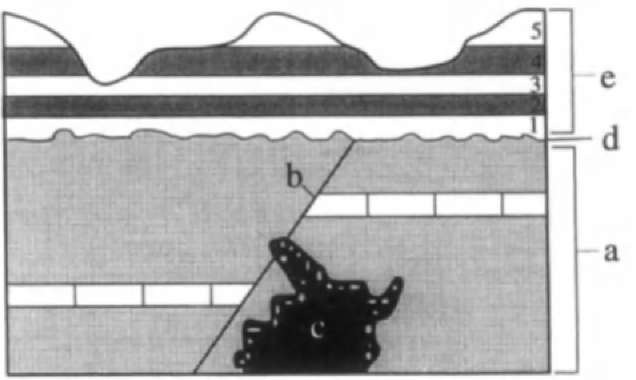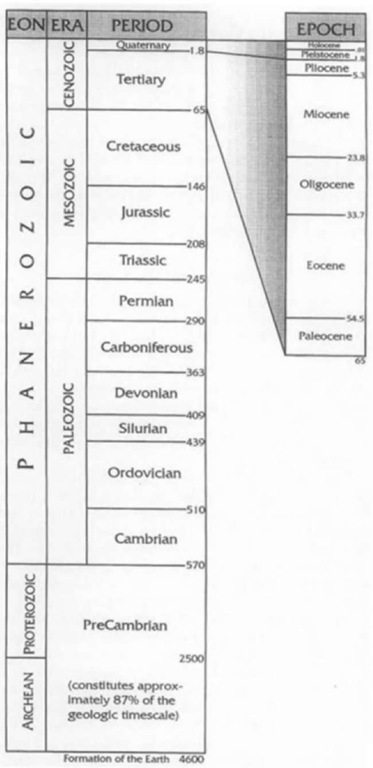Much of our concept of time is measured by our daily and yearly activities, but time in terms of Earth history is infinitely longer. Rather than increments of minutes, hours, or even years, geological time ticks by at millions and billions of years. The calendar of Earth’s existence is the geological time scale; a measure developed over the last four centuries by many geoscientists and paleontologists.
I. Methods for Deriving the Time Scale
A. Lithostratigraphy
The geological time scale is based on principles of lithostratigraphy that allow geologists to decipher a geologic history from a sequence of strata. These include the principle of superposition. developed in the late 17th century by Nicolaus Steno, which states that in any sequence of undisturbed strata, the oldest layers lie at the bottom and progressively become younger toward the top. In practical application, if a geologist can identify the bottommost and topmost beds in a sequence, he or she might also be able to infer the relative ages of those beds. Steno also founded the principle of original horizontality (under the influence of gravity, sediment will settle horizontal or parallel to the earth’s surface) and lateral continuity (as originally deposited, strata will extend laterally thinning at the basin margin), which further aid in the identification of beds and their relationship to one another.
In traveling through the world’s mountain belts, it is apparent that not all beds lie in a horizontal position, nor do they lie in undisturbed sequences. Therefore, the concepts and principles set forth by James Hutton and Charles Lyell in the 18th and 19th centuries broadened Steno’s original principles. Hut-ton’s concept of unconformities (a break or hiatus in the geologic record as represented by an erosional surface) not only allows stratigraphers to determine age relations within one sequence of strata, but also to correlate unconformities across great distances. This was followed by Lyell’s principle of cross-cutting relationships, which showed that any geologic feature that crosscuts another is younger than that feature. For the concept of inclusions. Lyell established that fragmentary bits (inclusions) of rock contained within another rock body are older than the enclosing mass. Taken together, the work of Lyell. Hutton, and Steno provide a lithostratigraphical basis for determining the ages of beds within and across outcrops. Figure 1 shows a geological history obtained from applying those stratigraphical principles and concepts.
B. Biostratigraphy
The physical position of rock units is not the only tool for deciphering the Earth’s geochronology, however. At the turn of the 18th century, William Smith noted that certain rock units often contained a particular assemblage of fossils. He used these assemblages to trace beds over short distances and also to correlate beds of different lithologies that contained the same fossils. These observations are the foundation of the principle of biologic succession, which stipulates that unique faunas characterize different periods in Earth’s history, and that the identification of similar faunas in disparate deposits will allow geologists to infer chronological correlations between the deposits. Sixtv years later. Charles Darwin would place Smith’s biologic succession in an evolutionary context
Figure 1 Geologic crosssection and associated relative geochronology obtained by appltjing stratigraphic principles. Chronologically from oldest to youngest are (a) deposition of light gray and block units; (b) faulting (principle of crosscut-ting relationships); (c) intrusion of igneous body with inclusion of light gray unit (principle of crosscutting relationships and Lyell’s concept of inclusions); (d) erosional surface (unconformity); and (e) deposition of horizontal strata (layer 1 being oldest, 5 youngest; principle of superposition). Quantitative dating methods such as radiometric or paleomagnetic dating tvotdd provide actual ages for some of the section. .
The use of fossils as time markers has advanced since Smith’s time, and we now recognize that both assemblages of fossils and individual genera are useful in geochronologic determinations. The most effective time markers are fossils known as index or guide fossils. These taxa have a short geologic existence but are geographically widespread or cosmopolitan. Consequently, these fossils can narrow the possible age limits for the strata in which they are found and simultaneously be correlated across great distances. By using multiple overlapping ranges of index fossils, even smaller increments of time can be determined. The discipline that has developed from fossil-based stratigraphic correlations is biostratigraphy.
C. Magnetostratigraphy
A more recent method for deriving a time scale is the use of paleomagnetic analysis. The Earth’s geomagnetic poles are inclined 11° from Earth’s rotational axis, and studies have shown that periodically these poles reverse, therefore our “North” today was our “South” 30,000 years ago. These reversals occur roughly ever)’ half million years but are interspersed with shorter reversals at erratic intervals (such as the one 30.000 years ago). The history of reversals is recorded in both sedimentary and igneous deposits. For igneous rocks, pole orientation is recorded when iron oxide minerals such as magnetite (Fe304) align themselves parallel to the poles bv crystallization in an igneous body. In the case of a cooling lava, alignment begins as the temperature nears 500° C. The magnetic declination preserved in the igneous rock on complete crystallization is known as thermoremanent magnetization. For sedimentary deposits, such as those on the ocean floor, grains of iron oxide will continually align themselves with the poles until lithifica-tion occurs; this is termed depositional remanent magnetization. The history of reversals as recorded in lava flows from around the world in combination with known radiometric dates have allowed scientists to construct a time scale based on ancient magnetism, the paleomagnetic time scale.
D. Radiometric Dating
The time scale framework established by stratigraphic and fossil studies has improved significantly over the last century with the advent of methods that allow for obtaining a quantitative geochronology. Within 10 years of the discovery of radioactivity. the phvsicist Ernest Rutherford suggested in 1905 that radioactive decay might be used to measure the actual age of a rock, and thus radiometric dating was born.
Decay occurs by particle emission from an atom, which results in the formation of another atom with a different composition. known as the daughter product. For example, the decay of uranium-238 will initially produce thorium-234 as its daughter product, and this process will continue until a stable configuration is obtained: in the case of uraniuin-238. the stable product is lead-206. Because each individual isotope has a particular mode and the length of decay that is unique, it is possible to determine the age of a particular specimen by measuring the amount of parent product versus daughter product by a mass spectrometer. For computational ease, the most useful increment to measure decay is half-life, the time required for half of the original quantity of radioisotope to decay. Half-lives are also unique for individual isotopes; for instance, carbon-14, which decays to nitrogen-14, has a half-life of 5730 years, and therefore is useful in dating recent organic materials. Whereas, uranium-238 has a half-life of 4468 million years, the isotope with the longest half-life is rubidium-87 (daughter product of strontium-87) with 48.800 million years.
II. Geochronologic Units
Bv applying stratigraphic and biostratigraphic principles, early geologists and paleontologists began construction of a relative geological time scale. This was based on the identification and correlation of chronostratigraphic units that represent the rocks deposited during a specific time interval. Chronostratigraphic units were then translated to geochronologic units representing increments in time. Figure 2 shows the time scale in its current form. It has been revised significantly over the last century with the use of quantitative methodologies and better stratigraphic constraint.
The largest division of the time scale is the Eon; in succession from oldest to youngest, there are three eons: the Archean, Proterozoic, and Phanerozoic. Collectively, the Archean and Proterozoic are referred to as the Precambrian and represent the largest span of Earth’s histoiy (approximately 87%). The rocks of the Archean and Proterozoic are predominantly igneous and metamorphic, although they do also contain the earliest records of bacteria, algae, and multicellular organisms.
The Phanerozoic, spanning 570 millions years ago (Ma) until today, is divided into progressively smaller units: the largest being the era, followed by the period, epoch, and finally age. The boundaries of these units indicate pronounced changes in fauna and flora or other geologic events. The oldest era, the Paleozoic, lasted 325 million years and is marked by a proliferation and diversification of shelly marine invertebrates in the early part (Cambrian through Silurian) and by bony and cartilaginous fishes, amphibians, reptiles, and mammal-like reptiles (therapsids) in the later part (Devonian through Permian).
The Paleozoic ended in a catastrophic mass extinction. Numerous marine invertebrates (rugose corals, spiny productid brachiopods, two orders of brvozoans. and many echinoderms) disappeared as well as over 70% of Permian amphibians and reptiles. It is hypothesized that the union of the supercontinent Pangaea with its associated climatic changes mav be responsible for the Permian mass extinction.
The Mesozoic era spans 180 million years of geologic history and contains three periods: the Triassic, Jurassic, and Cretaceous. During this time, two new vertebrate classes evolved, the birds and mammals, and other groups experienced impressive radiations. The Mesozoic also marked the breakup of Pangaea and greater development of the Tethys Seaway. However, the Mesozoic is probably best known for the amazing reptile faunas that dominated terrestrial and aquatic realms worldwide. The most spectacular representatives of this time are the dinosaurs.
Figure 2 Geological time scale. Dates along the right margin are millions of years before present. Geochronologic ages arc not shown.
Like the Paleozoic, the Mesozoic ended in biotie crisis with approximately 25% of all known families of animals eliminated, including dinosaurs, pterosaurs, and marine reptiles such as ichthyosaurs, plesiosaurs, and mosasaurs, as well as numerous invertebrates. This extinction occurred across what is known as the K-T boundary (Cretaceous-Tertiary boundary) and set the stage for the rapid diversification of all mammalian families during the Cenozoic era, the age of mammals.
The Cenozoic is composed of two periods, the Tertiary and Quaternary; the latter being the period in which we live today. These periods are additionally divided into epochs with the Pa-leocene. Eocene, Oligocene. Miocene, and Pliocene falling within the Tertiary, and the Pleistocene and Holocene within the Quaternary. Immense fossil collections have been amassed for the Tertiary and Quaternary’, and comparison with studies of known environmental and geographic change has allowed scientists to paint a clearer picture of this portion of Earth history than any other period.
Like man’ other mammal groups, marine mammals evolved and radiated during the early to middle part of the Tertiary. The first sirenians appear in the early Eocene with the primitive genus Prorastomus. They underwent a radiation in the middle Eocene followed by a gradual decline through the Miocene into the earliest Pliocene. Three genera are known in recent times (Trichechus, Hijdrodamalis. and Dugong). The fossil group Desmostylia appeared in the early Oligocene with the youngest representatives present in the middle to late Miocene.
Among cetaceans, the oldest representatives, archaeocetes, originate in the early Eocene, whereas the suborder Mysticeti appears in the late Eocene and Odontoceti in the early Oligocene. Within odontocetes, most of the major modern families are established by the middle to late Miocene and among mysticetes by the earliest to middle Miocene with the exception of esehrichtiids and neobalaenids, which appear in the Pleistocene. The younger geologic appearance of esehrichtiids and neobalaenids may not indicate their origin, but rather it may point to gaps in the fossil record.
For marine carnivorans, the oldest pinnipeds are late Oligocene in age. Although phocids appear in the middle Miocene, they are most abundant and diverse in recent times. Desmatophocids have a much shorter geological existence from the early to middle Miocene. Like phocids, the oldest odobenids are Miocene in age, although they enjoy their greatest diversity in the late Miocene-earlv Pliocene with only one species, Odobenus rosmarus, present today. The earliest otariids are late Miocene in age and, like phocids, the otariids are most species rich in recent times.


